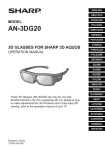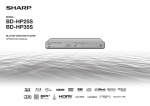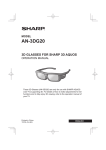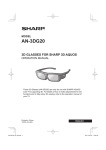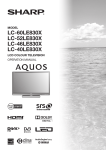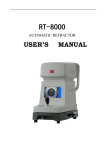Download Sharp Aquos TINS-E595WJQZ Specifications
Transcript
3D GLASSES FOR SHARP 3D AQUOS OPERATION MANUAL These 3D Glasses are only for use with SHARP AQUOS LCD TVs supporting 3D. For details of how to make adjustments for 3D functions and to fully enjoy 3D viewing, refer to the operation manual of your TV. Printed in Malaysia TINS-F225WJZZ 11P04-MA-NG DEAR SHARP CUSTOMER To ensure safety and many years of trouble-free operation of your product, please read the Important Safety Instructions carefully before using this product. IMPORTANT SAFETY INSTRUCTIONS 3D Glasses Prevention of accidental ingestion • Keep the accessory out of the reach of small children. Small children can accidentally swallow these parts. − If a child accidentally swallows any of these parts, seek immediate medical attention. Do not disassemble • Do not disassemble the 3D Glasses. Do not modify the 3D Glasses. Caution for lithium ion polymer rechargeable battery • Do not expose the battery to excessive heat, such as direct sunlight or fire, etc. Handling the 3D Glasses • Do not drop, exert pressure on, or step on the 3D Glasses. Doing so may damage the glass section, which may result in injury. • Be careful not to trap your finger in the hinge section of the 3D Glasses. Doing so may result in injury. − Pay special attention when children are using this product. Using the 3D Glasses • The 3D Glasses vision should be limited. Security advisory establishes a maximum of 3 hours visualization, and in any case no more than one show length, break included. • Use the 3D Glasses only for the specified purpose. • Do not move around while wearing the 3D Glasses. The surrounding area appears dark, which may result in falling or other accidents that may cause injury. Caring for the 3D Glasses • Use only the cloth provided with the 3D Glasses to clean the lenses. Remove dust and soil from the cloth. Any dust or other soiling on the cloth may result in scratches on the product. Do not use solvents such as benzene or thinners as doing so may cause the coating to peel off. • When cleaning the 3D Glasses, take care not to allow water or other fluids to come into contact with the glasses. • Always store the 3D Glasses in the case provided when not in use. • When storing the 3D Glasses, avoid very humid or hot locations. Viewing 3D images • If you experience dizziness, nausea, or other discomfort while viewing 3D images, discontinue use and rest your eyes. • Do not use the 3D Glasses if they are cracked or broken. Keep away from heat • Do not place the 3D glasses in a fire, near heat or in an area with high humidity. This product may cause a fire or injury from ignition or explosion of the built-in lithium ion polymer rechargeable battery. Caution regarding rechargeable battery • Use the supplied USB cable to connect to a USB terminal of a 3D compatible SHARP TV when recharging. Recharging using other devices may lead to battery leakage, heat generation or explosion. Caution regarding the power supply • Use the supplied USB cable to connect to a USB terminal of a 3D compatible SHARP TV for supplying power. Supplying power using other devices may lead to heat generation or explosion. EN-2 Using the 3D Glasses CAUTION • Not all consumers can experience and enjoy 3D TV. Some people suffer from stereo blindness which prevents them from perceiving the intended depth of 3D entertainment. Also, some people who watch 3D programming may experience initial feelings of motion sickness as they adjust to the picture. Others may experience headaches, eye fatigue or continued motion sickness, or some viewers might also experience epileptic seizures or strokes. Like a roller coaster, the experience is not for everyone. • The 3D Glasses are precision equipment. Handle them with care. • Improper use of the 3D Glasses or failure to follow these instructions can result in eye strain. • If you experience dizziness, nausea, or other discomfort while viewing 3D images, immediately discontinue use of the 3D Glasses. Using the binocular disparity 3D system of the TV with incompatible 3D broadcasts or software can make images appear with a cross talk blur or create overlapping images. • When viewing 3D images continuously, be sure to take a break periodically to prevent eye strain. • If you are nearsighted or farsighted or have astigmatism or a different level of eyesight between the left and right eyes, you should take the necessary steps, such as wearing eyeglasses, to correct your eyesight before viewing 3D images. The 3D Glasses can be worn over eyeglasses. • When viewing 3D images, keep the 3D Glasses horizontally level with the TV screen. If you tilt the 3D Glasses with respect to the TV screen, the images viewed by the left and right eyes may appear significantly different or images may appear overlapping. • View 3D images at the appropriate distance from the TV screen. The recommended distance is three times the effective height of the TV screen. • Be careful of your surroundings when viewing 3D images. When you view 3D images, objects may appear at a distance closer or farther than the actual TV screen. This may cause you to misjudge the distance to the TV screen and possibly result in injury if you accidentally hit the screen or surrounding objects. • The 3D glasses are not recommended for people aged less than 6. • When children are viewing 3D images, be sure a parent or guardian is present. Monitor children viewing 3D images, and if they show signs of discomfort, immediately discontinue use of the 3D Glasses. • People with a known history of photosensitivity and people with heart problems or poor health should not use the 3D Glasses. This can worsen existing health conditions. • Do not use the 3D Glasses for other purposes (such as general eyeglasses, sunglasses, or protective goggles). • Do not use the 3D function or 3D Glasses while walking or moving around. This may result in injuries due to running into objects, tripping, and/or falling. • When using the 3D Glasses, take care not to accidentally strike the TV screen or other people. Viewing 3D images may cause you to misjudge the distance to the TV screen and accidentally strike the screen, resulting in possible injury. • It is recommended that you do not view 3D images if you are sleep deprived or if you have been drinking alcohol. Supplied Accessories Make sure the following accessories are provided with the 3D Glasses. 3D Glasses (×1) Nose pad *1 (Large ×1, small ×1) USB cable*2 (×1) Operation manual (this publication) Glasses case (×1) I J Cleaning cloth (×1) Use the 3D Glasses nose pad as needed. The small nose pad is already attached. The supplied USB cable is a dedicated cable for the 3D Glasses. It does not operate when connecting with other USB devices. NOTE • The illustrations above are for explanation purposes and may vary slightly from the actual accessories. EN-3 Using the 3D Glasses Part names 5 1 2 3 4 1 5 Nose pad mount The dedicated nose pad can be mounted here. Infrared receiver Receives an infrared signal sent from the TV. The 3D Glasses turn off automatically after 10 minutes if no signal is received from the TV. NOTE • Do not soil or apply stickers or other obstacles to the infrared receiver. Doing so may block signals from the TV and prevent the 3D Glasses from working correctly. • Interference from other infrared communications equipment may prevent you from viewing 3D images correctly. 2 Power-supply terminal This terminal is for recharging. 3 3D/2D/OFF Switch This button switches between 2D and 3D modes. 4 LED light Blinks once every second when the battery power is low. Attaching the Nose Pad Using the 3D Glasses Attach either of the supplied nose pads as needed (such as when the glasses do not fit properly). The glasses come with a large and small nose pad. 1 1 Slide the switch to 3D to turn on the power. Slide the switch to OFF to turn off the power. 2 Attaching the nose pad Turning On/Off the Power Removing the nose pad NOTE • When the battery power is low, the LED light blinks once every second after the power is turned on. EN-4 Using the 3D Glasses Switching to 3D and 2D Mode 3 When viewing 3D images, you can slide the switch between 2D and 3D modes. This is useful when several people are viewing 3D images on the same TV with some people wanting to watch in 3D and some people wanting to watch in 2D. ■ Viewing 2D images ■ Viewing 3D images When you slide the switch to 2D while viewing 3D images, the 3D images switch to 2D images. When you slide the switch to 3D while viewing 2D images, the 2D images switch to 3D images. Usage Range of the 3D Glasses The 3D Glasses can be used by receiving an infrared signal sent from the TV. The 3D Glasses turn off automatically after 10 minutes if no signal is received from the TV. ■ After the recharge has completed, turn off the TV, and then remove the USB cable from the 3D glasses. Operating range From directly in front of the 3D infrared emitter on the TV: approx. 5 m (within approx. 30° horizontally and 20° vertically) Recharging the 3D glasses battery When the battery power is low, the LED light blinks one time per second. If the 3D glasses battery runs out, you can recharge the 3D glasses battery by connecting the supplied USB cable to the TV and the power-supply terminal on the 3D glasses. 1 Turn off the TV, and then slide the switch on the 3D glasses to OFF. 2 Connect the cable shown below before turning on the TV. • The LED light blinks once per two seconds, and then starts recharging. • When the LED light goes off, the recharge is complete. It takes 90 minutes to complete the recharge. • Insert the USB cable again if the LED light blinks on and off once every 0.5 seconds. If it still doesn’t respond, inquire with a retail dealer or SHARP customer service. 1 USB cable (supplied accessory) 2 Power-supply terminal CAUTION • Do not recharge while wearing the 3D glasses. NOTE • Be sure to turn on the TV when you recharge the 3D glasses battery. If the TV is turned off, you may not recharge it. • When you recharge the 3D glasses battery, only connect the USB cable (supplied accessory) to a USB terminal on the TV. • The battery will not recharge during usage with the USB cable connected. • Recharge the battery within the operating temperature (10°C–40°C/50°F–104°F). The battery may not be able to recharge outside of the operating temperature. Using the 3D glasses with an external power supply You can use the 3D glasses with an external power supply when you slide the switch on the 3D glasses to 3D or 2D after steps 1 and 2 in Recharging the 3D glasses battery (recharging will not complete). NOTE • Do not move around while wearing the 3D glasses. You may result in getting your feet caught in USB cable, the TV falling or other accidents that may cause injury. • When you supply power to the 3D glasses, only connect the USB cable (supplied accessory) to a USB terminal on the TV. • When you use the USB cable connecting the 3D glasses, careful not to get your feet caught in the USB cable. It may result in falling or other accidents that may cause injury. EN-5 Using the 3D Glasses NOTE • These 3D Glasses are only for use with SHARP LCD TVs supporting 3D. ■ 3D Glasses lenses ■ 3D Glasses infrared receiver ■ Caution during viewing • Do not apply pressure to the lenses of the 3D Glasses. Also, do not drop or bend the 3D Glasses. • Do not scratch the surface of the lenses of the 3D Glasses with a pointed instrument or other object. Doing so may damage the 3D Glasses and reduce the quality of the 3D image. • Use only the cloth provided with the 3D Glasses to clean the lenses. • Do not allow the infrared receiver to become dirty, and do not attach stickers to or otherwise cover the infrared receiver. Doing so may prevent the receiver from operating normally. • If the 3D Glasses are affected by other infrared data communication equipment, the 3D images may not be displayed correctly. • Do not use devices that emit strong electromagnetic waves (such as cellular phones or wireless transceivers) near the 3D Glasses. Doing so may cause the 3D Glasses to malfunction. • The 3D Glasses cannot operate fully at extreme high or low temperatures. Please use them within the specified usage temperature range. • If the 3D Glasses are used in a room with fluorescent lighting (50/60 Hz), the light within the room may appear to flicker. In this case, either darken or turn off the fluorescent lights when using the 3D Glasses. • Wear the 3D Glasses correctly. 3D images will not be correctly visible if the 3D Glasses are worn upside down or back-to-front. • Other displays (such as computer screens, digital clocks, and calculators) may appear dark and difficult to view while wearing the 3D Glasses. Do not wear the 3D Glasses when watching anything other than 3D images. • If you lie on your side while watching the TV with 3D Glasses, the picture may look dark or may not be visible. • Be sure to stay within the viewing angle and optimum TV viewing distance when watching 3D images. Otherwise, you may not be able to enjoy the full 3D effect. • The 3D Glasses may not work properly if there is any other 3D product or electronic devices turned on near the glasses or TV. If this occurs, turn off the other 3D product or electronic devices or keep the devices as far away as possible from the 3D Glasses. • Stop using this product in any of the following situations: − When images consistently appear doubled while you are wearing the 3D Glasses − When you have difficultly perceiving the 3D effect • If the 3D Glasses are faulty or damaged, stop using them immediately. Continued use of the 3D Glasses may cause eye fatigue, headaches and illness. • If you have any abnormal skin reaction, stop using the 3D Glasses. In very rare instances, such reactions may be due to an allergic reaction to the coating or materials used. • If your nose or temples become red or you experience any pain or itchiness, stop using the 3D Glasses. Pressure caused by long periods of use may lead to such reactions and may result in skin irritation. Troubleshooting Problem Possible Solution • Images displayed in 3D mode appear doubled while you are wearing the 3D Glasses. • Is the power of the 3D Glasses turned on? • Slide the switch to 3D to turn on the 3D Glasses. • Images displayed in 3D mode appear 2D while you are wearing the 3D Glasses. • Are the 3D Glasses set to 2D mode? • Slide the switch to 3D while viewing 2D images and the 2D images switch to 3D images. EN-6 Using the 3D Glasses Specifications Lens type Liquid crystal shutter Power supply DC5V (supplied by a USB terminal of a SHARP TV) Battery Lithium ion polymer rechargeable battery (DC3.7V 70mAh) Battery life*1 Approx. 30 hours of continuous use Charging time 90 minutes Dimension (W x H x D) 175.5 × 43.0 × 173.0 mm/6 15/16 × 1 23/32 × 6 13/16 inch Weight Approx. 40.0 g/0.1 lbs. (including the lithium ion polymer rechargeable battery) Operating temperature 10°C to 40°C/50°F to 104°F (The 3D Glasses cannot operate fully at extreme high or low temperatures. Please use them within the specified usage temperature range.) I Battery life: A rechargeable battery becomes depleted from repetitive usage, and the battery life gradually becomes shorter (the battery life varies with your usage environment). The above is the value at the factory default state and quality is not guaranteed by the value. The product serial number is displayed on the 3D Glasses as indicated in the illustration on the left. The first four digits represent the product color and the date of manufacture. Example: Black colored glasses manufactured on April 10, 2011 S/N : B 1 4 A Bottom Manufacture number Color B: Black Year of manufacture 1: 2011 2: 2012 Month of manufacture 1: 1 2: 2 3: 3 8 :8 9 :9 A : 10 B : 11 C: 12 Day of manufacture 1: 1 A : 10 2: 2 B : 11 3: 3 H : 17 J : 18 N : 22 P : 23 W: 30 X : 31 EN-7 * “I”, “O”, “Y” and “Z” are not used.









